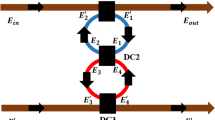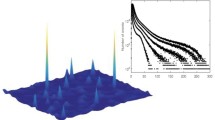Abstract
We consider chaotic dynamics of a system of two coupled ring resonators with a linear gain and a nonlinear absorption. Such a structure can be implemented in various settings including microresonator nanostructures, polariton condensates, optical waveguides or atomic Bose–Einstein condensates of ultra-cold atoms placed in a circular-shaped trap. From the theoretical point of view, this system is attractive due to its modulational instability and rich structure, including various types of spontaneous symmetry breaking, period-doubling bifurcations, eventually leading to chaotic regime. It is described by set of partial differential equations but we show that the so-called Galerkin approximation can explain most of the system characteristics mapping it on the dynamics of few coupled oscillator modes. The main goal of the present study is to investigate various routes to chaos in our non-Hermitian system and to show the correspondence between the continuous operator problem and its discrete representation.





Similar content being viewed by others
References
Smith, R.G.: Optical power handling capacity of low loss optical fibers as determined by stimulated Raman and Brillouin scattering. Appl. Opt 11, 2489 (1972)
Agrawal, G.P.: Nonlinear Fiber Optics, 3rd edn. Academic Press, SanDiego (2001)
Boyd, R.W.: Nonlinear Optics. Academic Press, SanDiego (1992)
Deng, L., Hagley, E.W., Wen, J., Trippenbach, M., Band, Y., Julienne, P.S.: Four-wave mixing with matter waves. Nature 398, 218 (1999)
Trippenbach, M., Band, Y.Y., Edwards, M., Doery, M., Julienne, P.S., Hagley, E.W., Deng, L., Kozuma, M., Helmerson, K., Rolston, S.L., Phillips, W.D.: Coherence properties of an atom laser. J. Phys. B 33, 47 (2000)
Lagoudakis, K.: The Physics of Exciton–Polariton Condensates. EPFL Press, CRC Press (2013)
Laussy, F.P., Timofeev, V., Sanvitto, D.: Exciton Polaritons in Microcavities: New Frontiers. Springer, Berlin (2012)
Deng, H., Weihs, G., Santori, C., Bloch, J., Yamamoto, Y.: Condensation of semiconductor microcavity exciton polaritons. Science 298, 199 (2002)
Kasprzak, J., Richard, M., Kundermann, S., Baas, A., Jeambrun, P., Keeling, J.M.J., Marchetti, F.M., Szymanska, M.H., Andre, R., Staehli, J.L., Savona, V., Littlewood, P.B., Deveaud, B., Si Dang, L.: Bose–Einstein condensation of exciton polaritons. Nature 443, 409 (2006)
Balili, R.B., Hartwell, V., Snoke, D., Pfeiffe, L., West, K.: Bose–Einstein condensation of microcavity polaritons in a trap. Science 316, 1007 (2007)
Deng, H., Haug, H., Yamamoto, Y.: Exciton-polariton Bose–Einstein condensation. Rev. Mod. Phys. 82, 1489 (2010)
Byrnes, T., Kim, N.Y., Yamamoto, Y.: Exciton-polariton condensates. Nat. Phys. 10, 10–13 (2014)
Sun, Y., Fan, X.: Optical ring resonators for biochemical and chemical sensing. Anal. Bioanal. Chem. 399, 205 (2011)
Braginsky, V.B., Gorodetsky, M.L., Ilchenko, V.S.: Quality-factor and nonlinear properties of optical whispering-gallery modes. Phys. Rev. A 137, 393 (1989)
Blom, F.C., van Dijk, D.R., Hoekstra, H.J., Driessen, A., Popma, T.J.A.: Experimental study of integrated-optics microcavity resonators: toward an all-optical switching device. Appl. Phys. Lett. 71, 747 (1997)
Post, E.J.: Sagnac effect. Rev. Mod. Phys. 39, 475 (1967)
Knight, J.C., Driver, H.S.T., Hutcheon, R.J., Robertson, G.N.: Core-resonance capillary-fiber whispering-gallery-mode laser. Opt. Lett. 17, 1280 (1992)
Yamamoto, Y., Slusher, R.E.: Optical Processes in microcavities. Phys. Today 46, 66 (1993)
Herr, T., Brasch, V., Jost, J.D., Wang, C.Y., Kondratiev, N.M., Gorodetsky, M.L., Kippenberg, T.J.: Temporal solitons in optical microresonators. Nat. Photonics 8, 145 (2014)
Guo, H., Karpov, M., Lucas, E., Kordts, A., Pfeiffer, M.H.P., Brasch, V., Lihachev, G., Lobanov, V.E., Gorodetsky, M.L., Kippenberg, T.J.: Universal dynamics and deterministic switching of dissipative Kerr solitons in optical microresonators. Nat. Phys. 13, 94 (2017)
Lucas, E., Karpov, M., Guo, H., Gorodetsky, M.L., Kippenberg, T.J.: Breathing dissipative solitons in optical microresonators. Nat. Commun. 8, 736 (2017)
Yu, M., et al.: Breather soliton dynamics in microresonators. Nat. Commun. 8, 14569 (2017)
Vahala, K.: Optical Microcavities. World Scientific Publishing, Singapore (2004)
Cundiff, S.T.: New generation of combs. Nature 450, 1175 (2007)
Kippenberg, T.J., Holzwarth, R., Diddams, S.A.: Microresonator-based optical frequency combs. Science 332, 555–559 (2011)
Gorodetsky, M.L., Lobanov, V.E., Lihachev, G., Pavlov, N., Koptyaev, S.N.: Kerr combs in microresonators: from chaos to solitons and from theory to experiment. Proc. SPIE 10090, 100900H–1 (2017)
Hung, N.V., Zegadlo, K.B., Ramaniuk, A., Konotop, V.V., Trippenbach, M.: Modulational instability of coupled ring waveguides with linear gain and nonlinear loss. Sci. Rep. 7, 4089 (2017)
Ramaniuk, A., Hung, N.V., Giersig, M., Kempa, K., Konotop, V.V., Trippenbach, M.: Vortex creation without stirring in coupled ring resonators with gain and loss. Symmetry 10, 195 (2018)
Ern, A., Guermond, J.-L.: Theory and Practice of Finite Elements. Springer, Berlin (2004)
Galerkin, B.G.: On electrical circuits for the approximate solution of the Laplace equation. Vestnik Inzh 19, 897 (1915)
Chekroun, M.D., Ghil, M., Liu, H., Wang, S.: Low-dimensional Galerkin approximations of nonlinear delay differential equations. Discrete Contin. Dyn. Syst. 36, 4133–4177 (2016)
Wanga, Y.-S., Chien, C.-S.: A spectral-Galerkin continuation method using Chebyshev polynomials for the numerical solutions of the Gross–Pitaevskii equation. J. Comput. Appl. Math. 235, 2740–2757 (2011)
Bland, T., Parker, N.G., Proukakis, N.P., Malomed, B.A.: Probing quasi-integrability of the Gross–Pitaevskii equation in a harmonic-oscillator potential. J. Phys. B: At. Mol. Opt. Phys. 51, 205303 (2018)
Driben, R., Konotop, V.V., Malomed, B.A., Meier, T.: Dynamics of dipoles and vortices in nonlinearly coupled three-dimensional field oscillators. Phys. Rev. E 94, 012207 (2016)
Wang, J., Zhou, Y., Liu, X.: A space-time fully decoupled wavelet Galerkin Method for solving multidimensional nonlinear Schrodinger equations with damping. Math. Probl. Eng. 11, 1 (2017)
Kukavica, I., Ugurlu, K., Ziane, M.: On the Galerkin approximation and strong norm bounds for the stochastic Navier–Stokes equations with multiplicative noise. Differ. Integral Equ. 31, 173 (2018)
Thiede, E., Giannakis, D., Dinner, A.R., Weare, J.: Galerkin approximation of dynamical quantities using trajectory data. arXiv:1810.01841
Kosiorek, A., Kandulski, W., Chudzinski, P., Kempa, K., Giersig, M.: Shadow nanosphere lithography: simulation and experiment. Nano. Let. 4, 1359 (2004)
Sigler, A., Malomed, B.A.: Solitary pulses in linearly coupled cubic-quintic Ginzburg–Landau equations. Phys. D 212, 305 (2005)
Takens, F.: Detecting strange attractors in turbulence. In: Rand, D.A., Young, L.-S. (eds.) Dynamical Systems and Turbulence, Lecture Notes in Mathematics, vol. 898, pp. 366–381. Springer, Berlin (1981)
Mane, R.: On the dimension of the compact invariant sets of certain nonlinear maps. In: Rand, D.A., Young, L.-S. (eds.) Dynamical Systems and Turbulence, Lecture Notes in Mathematics, vol. 898, pp. 230–242. Springer, Berlin (1981)
Abarbanel, H.D.I.: Analysis of observed chaotic data. Springer, Berlin (1995)
Schuster, H.-G., Just, W.: Deterministic Chaos: An Introduction. Wiley, Hoboken (1995)
Strogatz, S.H.: Nonlinear Dynamics and Chaos: With Applications to Physics, Biology, Chemistry and Engineering. Perseus Book Publishing, New York City (1994)
Akhmediev, N., Soto-Crespo, J.M., Town, G.: Pulsating solitons, chaotic solitons, period doubling, and pulse coexistence in mode-locked lasers: complex Ginzburg–Landau equation approach. Phys. Rev. E 63, 056602 (2001)
Akhmediev, N., Ankiewicz, A. (eds.): Dissipative Solitons: From Optics to Biology and Medicine, Lecture Notes in Physics, vol. 751. Springer, Berlin (2008)
Grelu, P. (ed.): Nonlinear Optical Cavity Dynamics: From Microresonators to Fiber Lasers. Wiley, Hoboken (2016)
Liu, G., Snoke, D.W., Daley, A., Pfeiffer, L.N., West, K.: A new type of half-quantum circulation in a macroscopic polariton spinor ring condensate. PNAS 112, 2676 (2015)
Acknowledgements
We are grateful to Bruno Eckhardt for interesting discussions. N.V.H. appreciates the hospitality of M.T. during his visit to Warsaw for scientific cooperation. K.B.Z. acknowledges support from the National Science Centre (Poland) through Project FUGA No. 2016/20/S/ST2/00366. J.Z. acknowledges support by PL-Grid Infrastructure and EU Project, the EU H2020-FETPROACT-2014 Project QUIC No. 641122. This research has been also supported by National Science Centre (Poland) under Projects 2016/22/M/ST2/00261 (M.T.) and 2016/21/B/ST2/01086 (J.Z.). N.V.H. was supported by Vietnam National Foundation for Science and Technology Development (NAFOSTED) under Grant Number 103.01-2017.55.
Author information
Authors and Affiliations
Corresponding author
Ethics declarations
Conflict of interest
The authors declare no conflict of interest.
Additional information
Publisher's Note
Springer Nature remains neutral with regard to jurisdictional claims in published maps and institutional affiliations.
Rights and permissions
About this article
Cite this article
Zegadlo, K., Nguyen, H.V., Konotop, V.V. et al. Route to chaos in a coupled microresonator system with gain and loss. Nonlinear Dyn 97, 559–569 (2019). https://doi.org/10.1007/s11071-019-04997-5
Received:
Accepted:
Published:
Issue Date:
DOI: https://doi.org/10.1007/s11071-019-04997-5




